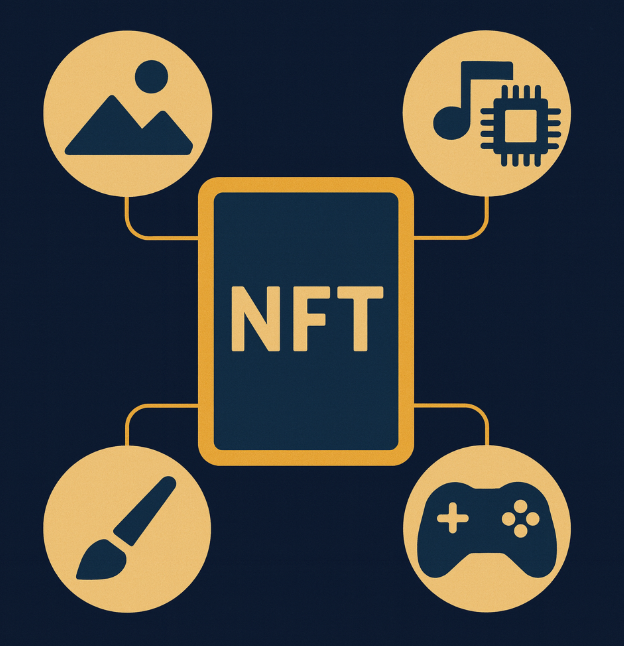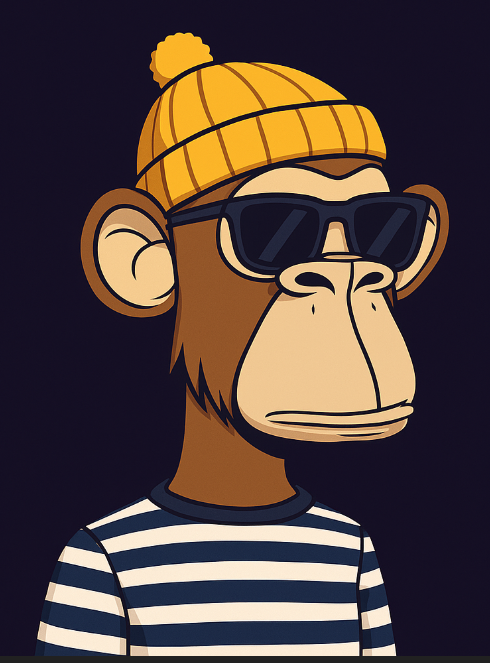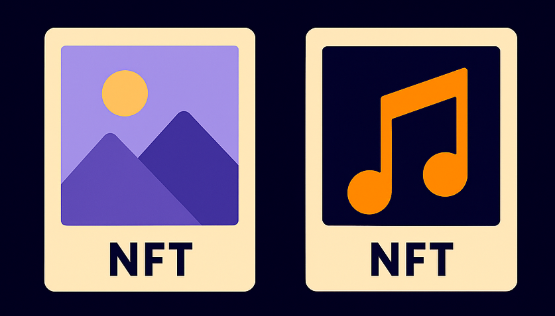Main > Blog > , You are here
The world of digital technology is constantly evolving, and a few years ago, an acronym burst onto the scene that had the effect of an exploding bomb — NFT. We heard about how ordinary NFT pictures sell for millions of dollars, how celebrities change their avatars to pixelated punks, and how mysterious NFT apes became the symbol of a new elite club. But for many, this topic is still shrouded in fog.
Is NFT just another bubble or a technology that will forever change our understanding of ownership in the digital world? In this article, we will break everything down and explain what NFTs are in simple terms. We will find out how they work, where they are used — from high art to games and even Telegram — and how anyone can create an NFT.
What is an NFT? An Explanation with a Simple Example
To understand what an NFT is, let's start with its full name: Non-Fungible Token. It sounds complicated, but it's actually quite simple.
Imagine you have a $100 bill. Your friend also has a $100 bill. They are absolutely identical and interchangeable. You can swap them, and nothing changes — you each still have $100. Such assets are called fungible. Most cryptocurrencies, like Bitcoin or Ethereum, are also fungible.
Now, imagine you have a concert ticket for a specific seat in the front row. Your friend also has a ticket to that concert, but in the back rows. These tickets are not equal and are not interchangeable. They both grant access to the concert, but they have unique properties (different seats, different prices). The same can be said for the "Mona Lisa" painting — it is one of a kind. Such assets are called non-fungible.
An NFT is, in essence, the digital equivalent of such a unique item. It is a record on the blockchain (most often Ethereum) that acts as a certificate of authenticity and ownership for a unique digital object. This object can be anything:
NFT pictures and digital works of art.
Music tracks and albums.
Videos, GIFs.
Items in video games.
Even tweets or domain names.
Thus, when you buy an NFT, you are not buying the picture itself (it can still be copied), but a unique token on the blockchain that irrefutably proves that you are the owner of the original.

How NFTs Work: The Technology Under the Hood
At the core of every NFT is a smart contract — a program that runs on the blockchain. This smart contract contains all the key information about the token:
A unique token identifier (ID).
A link to the digital object itself (e.g., to the NFT pictures), which is usually stored on decentralized file systems like IPFS.
Information about the creator.
The history of all its owners.
When someone decides to create an NFT, they are essentially launching this smart contract on the blockchain. This process is called "minting." After minting, the token receives its unique address, and it can no longer be forged, changed, or deleted. The entire transaction history of this token will be permanently recorded on the public ledger, ensuring complete transparency.
NFT Apes and The Most Expensive NFTs: A Revolution in Art
NFTs gained their greatest popularity in the realm of digital art. Previously, artists faced a problem: how to sell a digital work if it can be endlessly copied without any loss of quality? NFT technology solved this problem by creating the concept of "provable digital scarcity."
This is precisely what led to the phenomenon of the NFT apes. A collection of 10,000 unique images of bored apes called the Bored Ape Yacht Club (BAYC) took the market by storm. Each NFT ape is not just a picture but a membership to an exclusive club with access to private events and perks. Celebrities like Eminem, Justin Bieber, and Paris Hilton became owners of these NFT apes, which fueled the interest even more.
Speaking of the most expensive NFTs, one cannot fail to mention the artist Beeple (Mike Winkelmann). His collage "Everydays: The First 5000 Days" was sold at a Christie's auction for a record $69.3 million. This moment was a turning point, proving that digital art can be valued on par with traditional art.

Applications of NFT: Games, Avatars, and Telegram
Although NFT pictures remain the most famous application, the technology is penetrating other spheres.
What are NFTs in Games?
In the gaming industry, NFTs are ushering in the era of Play-to-Earn. In-game items — swords, armor, skins, land — can be issued as NFTs. This means that:
You truly own your items: Unlike in traditional games where all your purchases belong to the developer, here you are the rightful owner.
You can sell them: You can sell your in-game assets on special marketplaces for real money.
Interoperability: In the future, it may be possible to transfer items from one game to another if they are built on the same standard.
NFT Avatars and Digital Identity
Collections like BAYC have popularized the use of NFT avatars. Your avatar on social media becomes more than just a picture; it's a digital status symbol that proves your affiliation with a certain community. Twitter has even integrated a feature that allows you to verify your NFT and display it in a hexagonal frame.
What are NFTs in Telegram?
Relatively recently, the messenger Telegram introduced its own blockchain platform, TON, and the Fragment marketplace. This brought NFTs into the world of messengers. NFTs on Telegram are primarily:
Unique usernames: Users can now buy and sell beautiful and short usernames (@username) at auctions. Ownership of such a username is recorded on the TON blockchain.
Anonymous numbers: The ability to buy a special virtual number to register on Telegram without a SIM card, the ownership of which is also a token.
Many users also ask about NFT gifts on Telegram. While you cannot directly gift a Telegram NFT (username) yet, you can gift a Telegram Premium subscription, which is purchased with the TON cryptocurrency and is part of the same digital ecosystem. Thus, NFTs on Telegram are becoming a new way to customize and own a digital identity within the messenger.

How to Create an NFT: A Quick Guide for Beginners
Many are interested in how to create an NFT and whether it's possible to earn from it. The process has become quite simple and does not require programming skills.
Here are the basic steps to create an NFT:
Get a wallet: You will need a crypto wallet that supports NFTs, such as MetaMask.
Buy cryptocurrency: To create (mint) an NFT and pay for gas fees, you will need the cryptocurrency of the network you're using (most often Ethereum). The easiest way to do this is through a reliable cryptocurrency exchange, where you can quickly purchase ETH to get started.
Choose a marketplace: Register on one of the popular platforms, such as OpenSea, Rarible, or Foundation.
Upload your file: This could be your digital artwork, a photograph, a music track, etc.
Fill in the information: Give your NFT a name, add a description, and set a royalty (the percentage you will receive from each subsequent resale).
Click "Mint": Sign the transaction in your wallet and pay the fee. Your NFT will be created and recorded on the blockchain!
After that, you can list your token for sale by setting a fixed price or starting an auction.
The Future is Digital Ownership
So, NFTs are not just expensive pictures. They are a revolutionary technology that, for the first time in history, has allowed us to truly own digital assets. It creates new economic models for artists, musicians, game developers, and many others.
Of course, the NFT market is still young, volatile, and associated with risks. But the fundamental idea — proving ownership via the blockchain — has enormous potential. From a unique social media avatar to a digital passport or a real estate deed, the applications of this technology are limited only by our imagination. And what starts today with NFT apes may become an integral part of our digital existence tomorrow.
